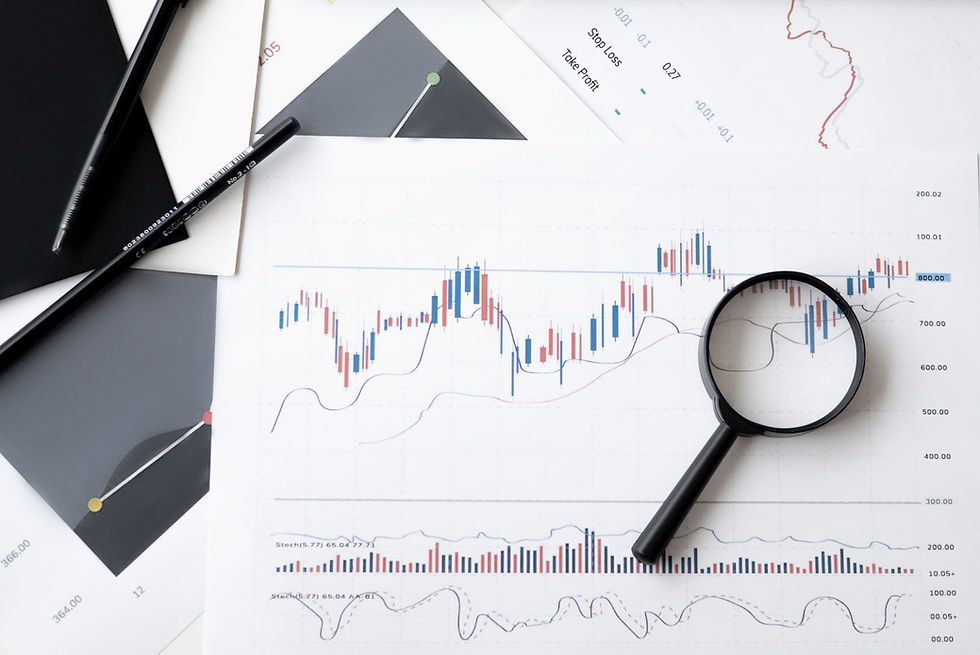Chapter 15: How to Trade Forex (A practical, step-by-step guide for beginners)
- Oct 15
- 7 min read
Updated: Oct 20
Trading forex isn’t magic — it’s a repeatable process made of edge + discipline + risk control. Below is a clear, actionable guide you can follow whether you’re starting today or sharpening an existing plan.
This chapter is a hands-on playbook you can follow start-to-finish. It’s written for a new trader who wants clear steps, concrete examples, and a repeatable process — not theory. Read it, print it, and use the checklists and templates as you practice.

1. Quick roadmap (what you’ll do)
Learn basics & terminology.
Pick a reliable broker and open a demo account.
Choose one simple strategy and backtest it.
Forward-test on demo for 30–90 days.
Start small live (strict risk rules).
Scale only when consistently profitable.
2. Core building blocks (must-know concepts)
Pair: EUR/USD, GBP/JPY etc. Base / quote.
Pip: smallest price move (for most pairs, 0.0001).
Lot sizes:
Standard lot = 100,000 units.
Mini lot = 10,000 units.
Micro lot = 1,000 units.
Spread: dealer’s buy/sell difference.
Leverage: borrowed exposure (e.g., 1:100).
Margin: collateral required for a position.
Swap: overnight interest (positive or negative).
Slippage: difference between requested price and executed price.
3. Set up — broker, platform, and safety checks
Broker checklist (must pass)
Regulator: FCA / ASIC / CySEC / or clearly disclosed entity for your country.
Segregated client funds & negative-balance protection (if offered).
Fast withdrawals & multiple local payment options.
Tight spreads on the pairs you’ll trade.
Accepts small deposits for demo→live testing.
Compatible with RebateTraderX if you want rebates.
Platform
Start with MT4 or MT5 (industry standard) or a simple web UI.
Install platform, verify connection, add an economic calendar, and set your timezone.
4. Create a simple trading plan (template)
Fill this out before every trade and keep it as your rulebook.
Account currency: ______
Strategy name: ______
Timeframe: (M5 / M15 / H1 / D1) ______
Instruments: (EUR/USD, GBP/USD) ______
Risk per trade (% of account): ______ (recommended 0.25%–1%)
Max daily loss limit (%): ______ (recommended 2–4%)
Max open trades: ______
Entry rules (exact): ______
Stop loss rules (exact pips): ______
Profit target / exit rules: ______
Position sizing formula: Lot size = (AccountRiskAmount) / (StopLossPips × PipValue)
Review cadence: (daily/weekly/monthly) ______
5. A simple example trading strategy (ready to test)
Name: 50-EMA Trend Pullback (1H)
Pair: EUR/USD
Timeframe: 1-hour chart
Indicators: 50-EMA (exponential moving average), ATR(14) for volatility
Entry:
When price is above 50-EMA (uptrend) and price pulls back to touch or slightly pierce the 50-EMA, wait for the next bullish candle close above the previous candle high; enter long on that close.
Stop Loss: 1.5 × ATR(14) below entry.
Take Profit: 2 × risk (or trail with 21-EMA).
Risk per trade: 0.5% of account.
Example position sizing — step-by-step arithmetic
Assume:
Account balance = $5,000
Risk per trade = 0.5% → AccountRiskAmount = 0.5% of $5,000.
0.5% = 0.005 in decimal.
0.005 × 5,000 = step-by-step:
5,000 × 0.005 = 25.00 → $25 risk per trade.
Stop-loss distance = 30 pips.
Pair = EUR/USD → Pip value for a standard lot = $10 per pip. For smaller lots: mini = $1 per pip, micro = $0.10 per pip.
Lot size formula:
LotSize (standard lots) = AccountRiskAmount / (StopLossPips × PipValue)
Compute denominator:
StopLossPips × PipValue = 30 pips × $10/pip = step-by-step:
30 × 10 = 300 → $300.
Now LotSize:
LotSize = $25 / $300 = step-by-step:
25 ÷ 300 = 0.083333... → 0.0833 standard lots.
Convert to micro/mini:
0.0833 standard lots = 8.33 mini lots? Wait: 1 standard lot = 10 mini lots.
0.0833 × 10 = 0.833 mini lots (not practical).Better convert to micro lots (1 micro = 0.01 standard):
0.0833 standard lots = 8.33 micro lots (since 0.01 standard = 1 micro).So we’d place 0.08 standard lots or 8 micro lots (rounded to broker minimum increments).
Practical note: round down to avoid exceeding risk. Use 8 micro lots (0.08 standard) here.
6. Backtesting & forward testing (how to validate)
Backtesting steps (manual or software)
Define exact rules (entry, stop, exit, time).
Use historical data on your platform for the chosen timeframe.
Test at least 200 trades if possible (or multiple years of data).
Record: Win rate, Avg win (in pips/$), Avg loss, Max drawdown, Profit factor.
Calculate Expectancy:
Expectancy = (WinRate × AvgWin) − (LossRate × AvgLoss)
Example (digit calculation): WinRate 40% = 0.40; AvgWin = $150; LossRate 60% = 0.60; AvgLoss = $100.
0.40 × 150 = step-by-step: 0.4 × 150 = 60.0
0.60 × 100 = step-by-step: 0.6 × 100 = 60.0
Expectancy = 60.0 − 60.0 = 0.0 (zero expectancy — not profitable).
Only forward-test if expectancy positive and drawdown acceptable.
Forward test (demo)
Trade on demo for 30–90 days with real execution timing and slippage awareness.
Keep live-like risk settings (realistic lot sizes vs account).
Record same metrics and compare to backtest.
7. Trade execution checklist (pre-entry)
Market session: is liquidity high for this pair? (see cheat-sheet)
Spread acceptable? (compare with historical spreads)
News within next 60 minutes? If yes, avoid or reduce size.
Stop loss & take profit set per plan.
Position size checked and obeys risk per trade.
Record planned trade in journal before clicking “Buy/Sell.”
8. Trade journal (daily template)
Use a spreadsheet with columns:
Date | Time | Pair | TF | Direction | Entry | SL | TP | Size (lots) | Risk $ | Outcome (P/L $) | Pips | Notes
Weekly review metrics:
Number of trades, Win rate, Avg win, Avg loss, Expectancy, Max drawdown, Profit factor.
9. Risk management rules (non-negotiables)
Risk per trade: 0.25%–1% (pick based on psychology & account size).
Max daily loss stop: e.g., 2% of account balance → stop trading for the day.
Max consecutive losing trades rule: pause and review after 3–5 losers in a row.
Use limit orders where possible, but always have a stop.
Do not add to losing positions (averaging down) unless strategy explicitly allows and you have a plan.
10. Psychology & routine
Pre-market routine: scan high-probability setups for your pair(s), check economic calendar, note open positions.
During trading: keep a calm posture; avoid revenge; follow the plan.
Post-market review: log trades, screenshots, and 1–2 lessons per trade. Weekly list top 3 improvements.
11. Practical things: money, taxes, bookkeeping
Keep trading account separate from living funds.
Keep records of trades and withdrawals for tax reporting.
Learn tax rules in your country — profits may be capital gains or income tax.
12. Transitioning DEMO → LIVE (safe process)
Demo: 30–90 days, meet target metrics (win rate, expectancy, drawdown).
Small live: fund e.g., $100–$1,000 depending on comfort. Trade identical plan and size proportional to demo results.
Track slippage and execution differences; if live performance is worse, analyze and fix before scaling.
Increase size slowly: e.g., double size only after 3 consecutive months meeting goals.
13. Tools that save you money & time
Rebate programs — reduce per-lot cost (RebateTraderX shows partner rates).
VPS — for automation and 24/7 EAs.
Economic calendar — avoid trading at bad times.
Trade journal software — TradesViz, Edgewonk, or simple Google Sheets.
14. 30-Day practice plan (daily checklist)
Day 1–7 (Learn & Setup)
Read basics and glossary. Install MT4/MT5, connect demo. Choose 1 pair.
Paper trade 10 demo trades following plan — note results.
Day 8–20 (Backtest & Demo)
Backtest rules on 3+ months data. Fine-tune stop rules using ATR.
Demo trade 30–50 trades; compute metrics: win rate, avg win/loss, expectancy.
Day 21–30 (Refine & Prepare Live)
If metrics consistent (positive expectancy, acceptable drawdown), prepare live account. Fund small.
Execute 20 live trades with 0.25% risk per trade. Compare demo → live.
15. Common beginner pitfalls & fixes
Too many strategies → Pick one.
Overleverage → lower leverage or use less risk per trade.
No stop loss → always set a stop.
Chasing losses → enforce daily stop limit.
Ignoring slippage/commissions → factor these into backtest.
16. Example trade walk-through (realistic)
You see EUR/USD above 50-EMA, pullback to EMA, bullish confirmation candle.
Account $2,000. Risk 0.5% → risk $ calculation: 0.005 × 2000 = step-by-step: 2000 × 0.005 = 10 → $10.
Stop loss 20 pips. Pip value standard lot $10 → denominator = 20 × 10 = 200 → $200.
LotSize = $10 / $200 = 0.05 standard lot. (0.05 standard = 5 micro lots)
Place buy with SL 20 pips below, TP 40 pips (2× risk).
If hit TP: profit = 40 pips × pip$10 × lot 0.05 = compute:
Profit per pip for 0.05 lots = $10 × 0.05 = step-by-step: 10 × 0.05 = 0.5 → $0.50 per pip.
40 pips × $0.50 = step-by-step: 40 × 0.5 = 20.0 → $20 profit.
Return on account = $20 / $2,000 = step-by-step: 20 ÷ 2000 = 0.01 → 1.0% gain on account for that trade.
17. Metrics to track (weekly & monthly)
Total trades
Win rate (%)
Avg win (pips & $)
Avg loss (pips & $)
Expectancy per trade ($)
Max drawdown (%)
Profit factor = gross profit / gross loss
Sharpe ratio (optional for more advanced)
18. When to stop / review
If monthly drawdown > 10% → pause and deep review.
If daily loss > your max daily loss → stop trading that day.
If expectancy falls below zero for the last 100 trades → halt and analyze.
19. Final checklist before you trade (one-line)
Strategy rules defined ✔ | Risk per trade set ✔ | Stop & size confirmed ✔ | News & spreads checked ✔ | Trade logged ✔
20. Glossary (short)
Ask = price to buy. Bid = price to sell. Spread = Ask − Bid.
Pip = smallest move (0.0001). Lot = trade size.
ATR = Average True Range (volatility). EMA = Exponential Moving Average.
Trading is a skill built one trade at a time. Follow the plan, protect capital, and validate everything with data. Use rebates (RebateTraderX) and careful broker selection to tilt the odds in your favour by lowering costs.



Comments